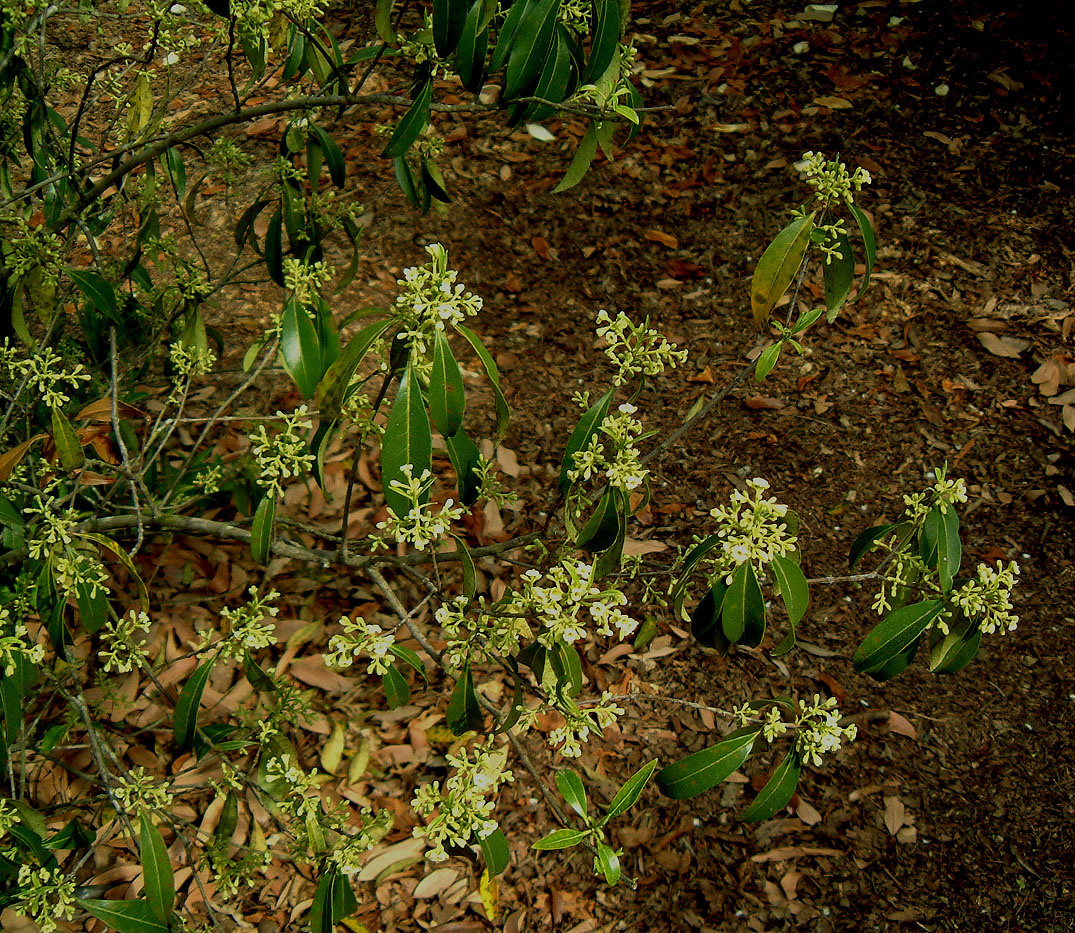 americanus - click image
americanus - click image| NOS OSMANTHUS PAGE |
| Copyright 1998-2002. New
Ornamentals Society. All Rights Reserved. Lawful for online access only by current society members. All downloading, printing, saving to media, imaging, screen capture, or offline use is prohibited. Duplication by any means, method, or technology is unlawful. Do not link to this page. |
Osmanthus americanus
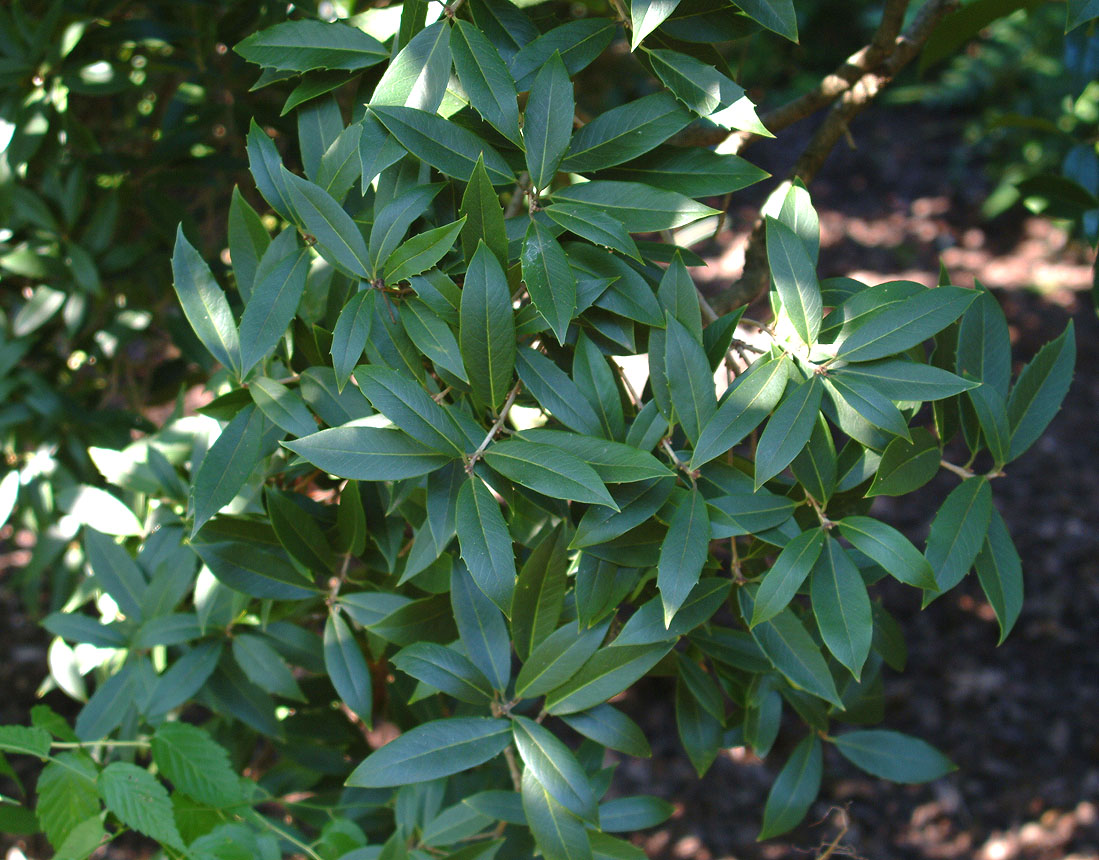 armatus - click image
armatus - click image
JC Raulston Arboretum. Fall 2003. The species is heterophyllous with both highly
toothed and more entire phases. This spray appears on a older
plant of about 20 years and 15 feet in height.
Osmanthus armatus
Osmanthus x burkwoodii
Osmanthus delavayi
Osmanthus
delavayi 'Heaven Scent' (10/01)
ht: 2m
ha: dense, upright
lc: medium green (RHS 147A) above, lighter green below (RHS
146B), becoming
lc: more yellow in cooler weather.
fc: white (RHS 155D)
ff: highly scented
fq: floriferous
or: Paradise Plants, Kulnura, NSW, Australia as open-pollinated
seedling before 1999
li: Cherry, R.J. 1999. Plant Varieties Journal 12(3): 28-29
Osmanthus
delavayi 'Pearly Gates' (10/01)
ht: 2m
ha: dense, upright, spreading
lc: dark green (RHS 147A) above, lighter green below (RHS 147B),
becoming
lc: more yellow in cooler weather.
fc: white (RHS 155D)
ff: highly scented
fq: floriferous
or: Paradise Plants, Kulnura, NSW, Australia as open-pollinated
seedling before 1999
li: Cherry, R.J. 1999. Plant Varieties Journal 12(3): 29
Osmanthus
x fortunei 'Carl Wheeler' (10/02)
in:
Tom Dodd Nurseries (online catalog
2002 and probably before)
Osmanthus
x fortunei 'Equinox'
lc: dark green sectored 1/2 or partially white
lc: new growth is often chartreuse
lc: some shoots may be entirely white
li: Hahn, C.R. and B.R. Yinger. 1983. Cultivars of Japanese
plants at
li: Brookside Gardens. Arnoldia 43(4): 15.
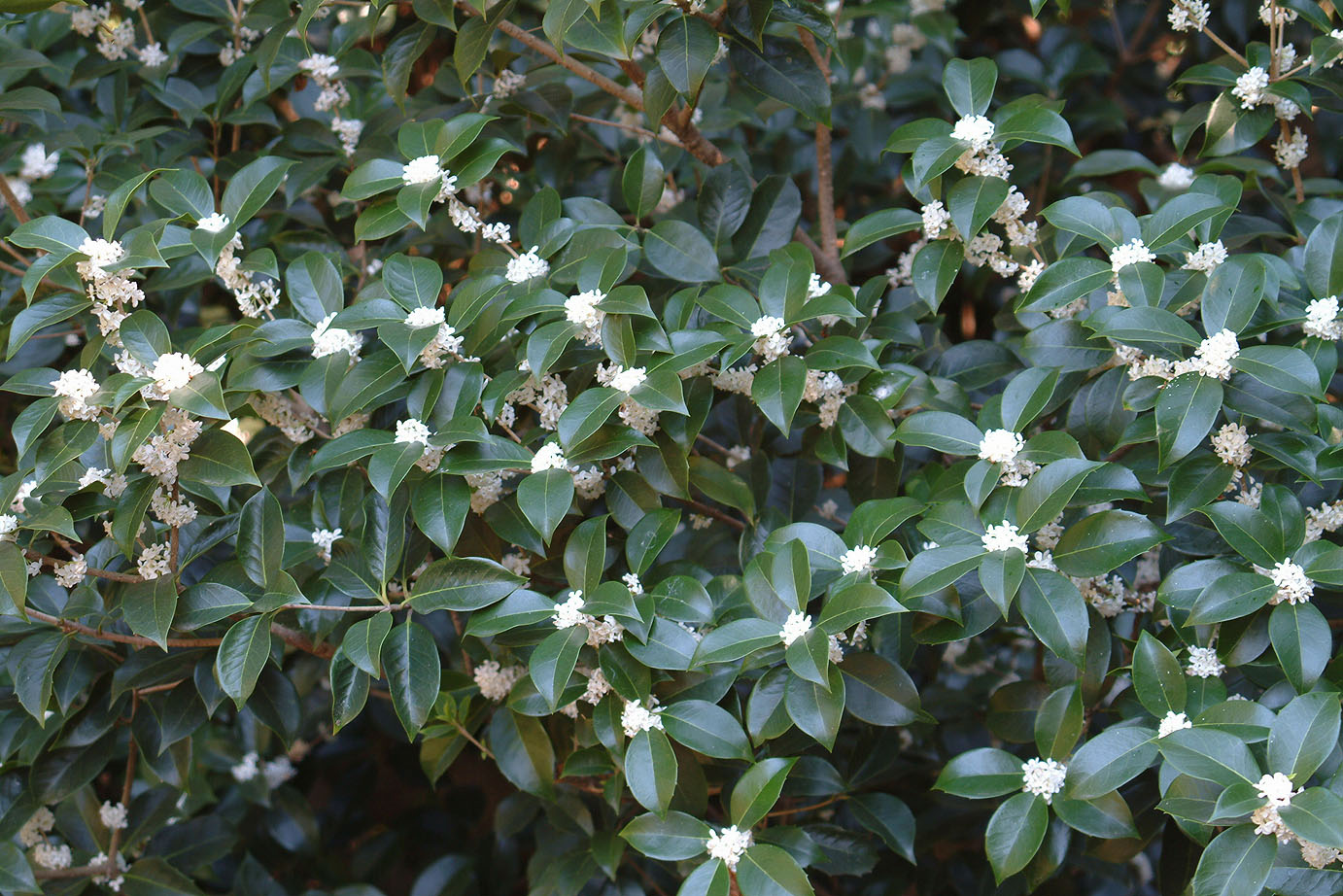 x fortunei 'Fortunei' - click image
x fortunei 'Fortunei' - click image
Osmanthus x fortunei 'Fortunei'
ht: 20 ft. tall x 20 ft. wide
ha: densely globose to broadly mounded, usually a multi-stemmed tree after 20
years or so. In the modern
ha: "crime aware" age they are usually limbed up (lower branches removed) to be
more tree-like. Otherwise
ha: they would form a near perfect dark hiding place for people bent on mischief
or worse.
lc: glossy dark green
fq: very floriferous in some climates such as the southeastern US
ff: very richly scented. I have detected plants hundreds of feet away. It is
sometimes a fun thing to look for
ff: for the culprit when in a large garden or campus. You smell the wonderful
odor before you may see it.
id: this name applies to the original clone
Osmanthus x fortunei
'Natchez'
ht: 20 ft.
lc: darker green
fq: flowers more abundant
or: Natchez MS - received at Woodlanders Inc.
so: Woodlander's Inc. 803-648-7522
Osmanthus fragrans f.
aurantiacus
fc: some shade from yellow to orange, usually on the later and
darker side
id: typical species (that is, f. fragrans) is white, cream, or
light yellow in flower color.
eval: named clones listed below are to be preferred.
Osmanthus
fragrans f. aurantiacus 'Apricot Gold'
fc: apricot orange color
ff: good scent
li: Louisiana Nursery, Opelousas LA USA Catalog 1990-1992: 72
Osmanthus fragrans f.
aurantiacus 'Aurantiacus'
fc: flowers light orange
ns: the forma denotes any of the orange variants
Osmanthus fragrans f.
aurantiacus 'Butter Yellow'
fc: "butter yellow"
fq; floriferous
li: Louisiana Nursery, Opelousas LA USA Catalog 1990-1992: 72
Osmanthus
fragrans 'Conger Yellow' ('Conger's Yellow')
fc: bright yellow
ff: very fragrant
ch: more cold hardy at NCSU Arb. than typical species
li: Louisiana Nursery, Opelousas LA USA Catalog 1990-1992: 72
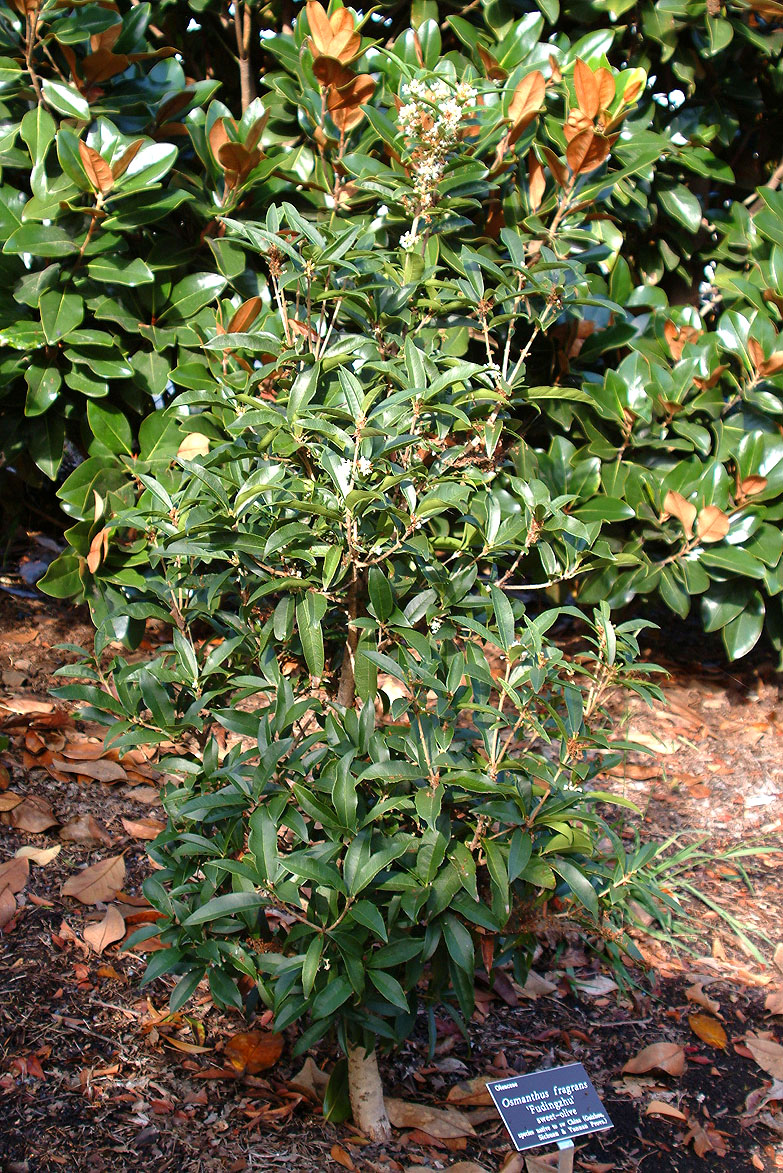 'Fudingzhu' - click image
'Fudingzhu' - click image
JC Raulston Arboretum. Fall 2003.
Osmanthus fragrans
'Fudingzhu'
fc: creamy-white
fq: very floriferous
ff: very fragrant
bt: said to bloom for 9 months which is not really accurate. It
really can bloom two months in the fall with some flowers in
early Spring.
Osmanthus fragrans 'Hunter's
Creek'
ha:
globose, taller
ht: 20 ft.
fc: creamy white - typical color?
ff: very fragrant
rai: may be regarded as an improvement of the species type
Osmanthus fragrans
'Latifolia' (var. latifolia)
fc: light creamy yellow
ff: fragrant
it: fls. solitary or clustered
bt: June to September is possible
ch: 8 - less cold hardy
Osmanthus fragrans 'Live Oak
Gold'
fc: bright yellow
ff: scented
ha: globose
li: Louisiana Nursery, Opelousas LA USA Catalog 1990-1992: 72
Osmanthus
fragrans 'Nanjing's Beauty' = 'Fudingzhu'
ns: we believe the original Chinese name has priority and should
be retained. No doubt the difficulty in
ns: spelling the older name and its possible resemblance to
profanity on a label is the reason for this newer name.
Osmanthus fragrans f.
aurantiacus 'Orange Supreme'
ha: tall
fc: bright orange
ff: scented
li: Louisiana Nursery, Opelousas LA USA Catalog 1990-1992: 72
Osmanthus fragrans
'Semperflorens'
fc: creamy white - typical
bt: very long bloom period - for months at least
ch: 6-7 - one of the more cold hardy clones, proven down to -15
F.
Osmanthus fragrans 'T-Tower'
ha: smaller, apparently tower-like?
fc: white
Osmanthus 'Hess'
ht: 15 ft.
ha: upright
dense
and vigorous
lc: dark green
fc: white
ff: fragrant
ch: USDA 7. Proven hardy on parts of Long Island.
so: under O. armatus - Roslyn Nursery
Osmanthus heterophyllus
'Akebono'
lc: entirely light yellow in a shade lighter than 'Ogon' becoming
green
lc: by summer but with a thin yellow green margin and all green
the
lc: second year. At the Raulston Arboretum it is mostly green in winter with
lc: some shoots irregularly cream margined and striped cream to the margins.
ls: 8-13 spinose teeth
or: Garden Wako of Yamamoto Japan
ns: the cultivar name means dawn
li: Hahn, C.R. and B.R. Yinger. 1983. Cultivars of Japanese
plants at
li: Brookside Gardens. Arnoldia 43(4): 15.
Osmanthus heterophyllus
'Argenteomarginatus'
ha: "tight upright dwarf"
lc: white margined
id,ns : probably ordinary 'Variegatus' which is often compact and
slow at first. This Latin name does
id,ns: not seem to have any validity.
li: Louisiana Nursery, Opelousas LA USA Catalog 1990-1992: 72
Osmanthus
heterophyllus 'Aureomarginatus' ('Aureus')
lc: margined yellow
lm: typically spinose unlike 'Aureus' which is often entire
id: those of 'Variegatus' are edged white to creamy white
Osmanthus heterophyllus
'Aureus'
lc: margined yellow or mostly yellow on some leaves
lm: typically entire or with one spinose apical tooth unlike
'Aureomarginatus'
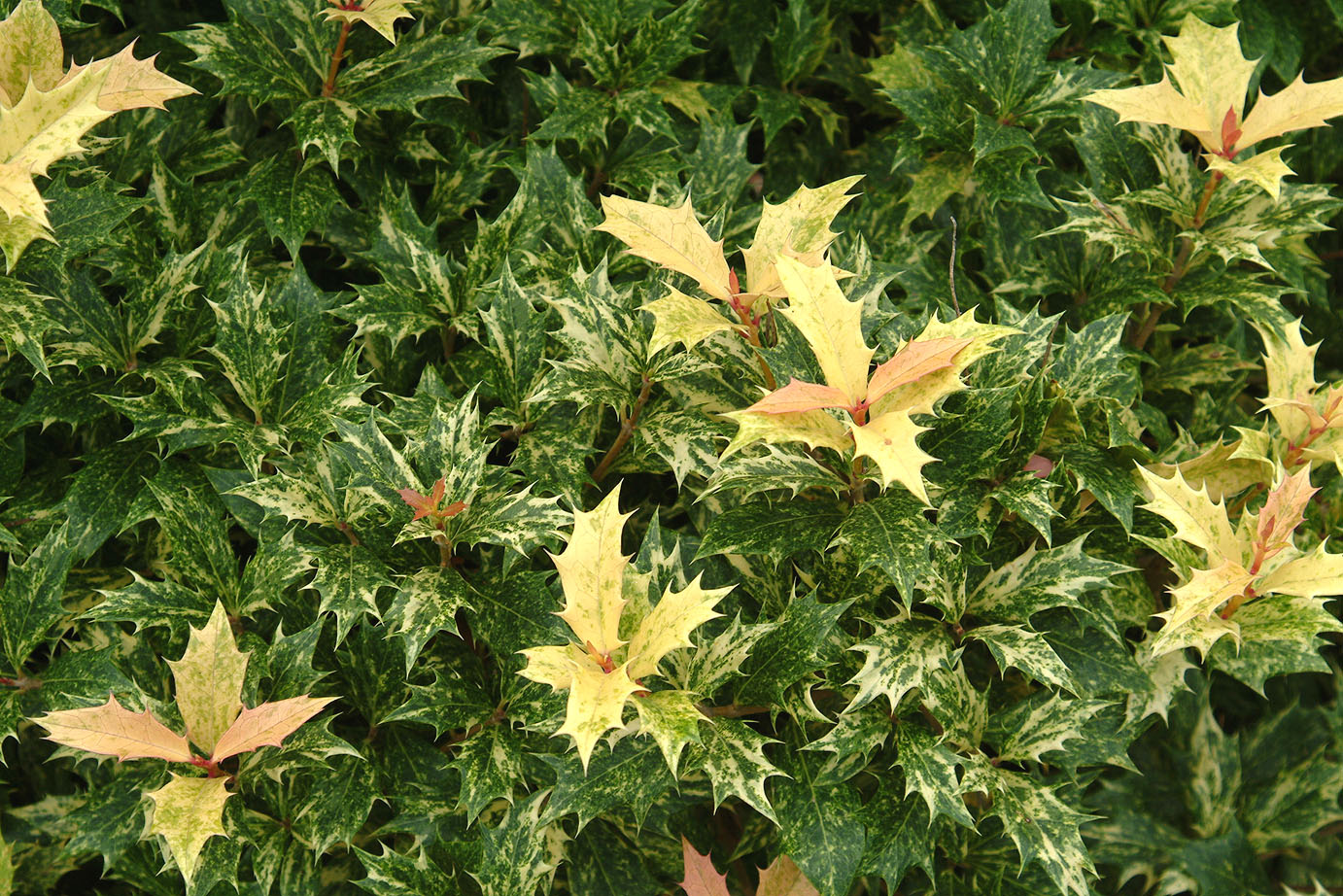 'Goshiki' - click image
'Goshiki' - click image
Osmanthus heterophyllus
'Goshiki'
lc: speckled white and grey to creamy white but tinged pink in the creamier,
less mottled new leaves. A late
lc: summer pruning will keep it colorful for week to come.
ls: 7-9 spinose teeth of unfirom size
evHatch: of maculated or spotted broadleaf evergreens this is one
of the best
ns: the cultivar name means five colors. If you pull out your RHS Colour Chart
you may find 12 or more colors!
li: Nihon Kaki Nursery Spring 1980 catalog: 34
li: Hahn, C.R. and B. Yinger. 1983. Cultivars of Japanese plants
at
li: Brookside Gardens. Arnoldia 43(4): 15
so: Woodlander's Inc. 803-648-7522
so: under O. armatus - Roslyn Nursery
Osmanthus heterophyllus
'Gulftide'
ht: 10-15 ft.
lm: deeply incised and spinose as are many species examples
ll: often larger than typical species ('Illicifolius')
or: Gulfstream Nur. of VA
ch: reliably USDA 7.
ns: best regarded as a superior largeleaf clone of the typical
species
so: Woodlander's Inc. 803-648-7522
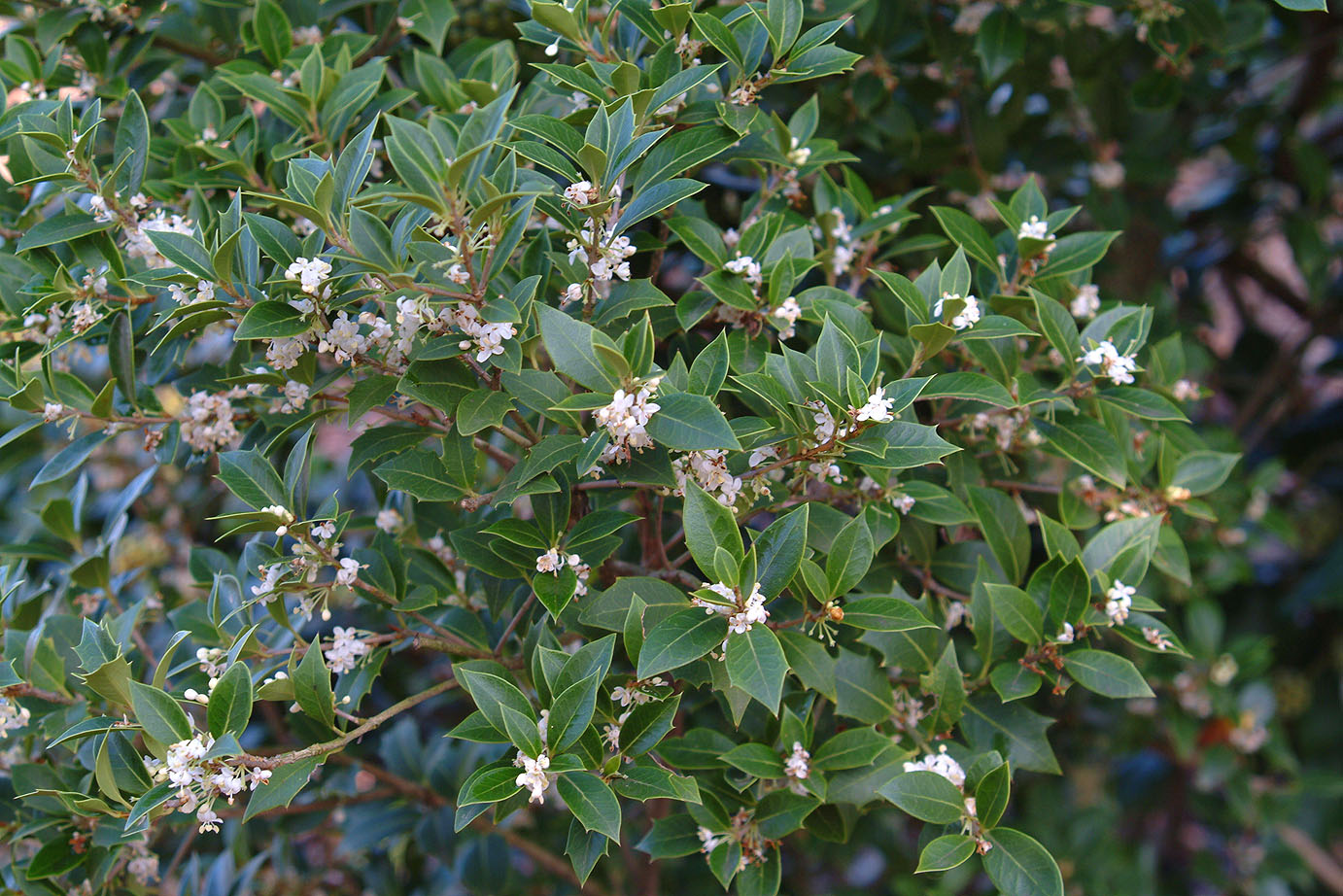 'Head-Lee Fastigiate' - click image
'Head-Lee Fastigiate' - click image
JC Raulston Arboretum. Fall 2003.
Osmanthus heterophyllus 'Head-Lee Fastigiate' (10/02)
ha: more narrow but not decidedly fastigiate nor even columnar as seen at the
JCRA.
fq: flowered profusely in 2003 at JCRA. Very good show and scent.
lm: very heterophyllous with 0-6 teeth per side.
or, lsp: J.C. Raulston Arboretum 1993, received from Head-Lee Nursery SC USA
Osmanthus
heterophyllus 'Illicifolius' = O.s. (typical species)
ns: this name is typical of the species in US gardens with deeply
cut
ns: spinose foliage. The name is mostly used to distinguish the
non-toothed
ns: and 'Rotundifolius' clones. 'Gulftide' is a typical named
clone of
ns: this holly-leaved extreme.
 Kembu' - click image
Kembu' - click image
JC Raulston Arboretum. Summer 2002.
Osmanthus heterophyllus
'Kembu'
lc: dark green with an irregular 'off white' margin. It is highly
lc: distinct from 'Variegatus' which has wide regular blades.
ll: 4-5cm
lw: 1-2cm
ls: very narrow and 'crescent-shaped' with irregular outline of
1-10 spinose
ls: teeth.
li: Hahn, C.R. and B.R. Yinger. 1983. Cultivars of Japanese
plants at
li: Brookside Gardens. Arnoldia 43(4): 15.
Osmanthus heterophyllus
'Maculifolius'
lc: blotched yellow
id: it has been suggested that this may be an old name for
'Goshiki'
id: although that clone is more white mottled than yellow.
 'Ogon' - click image
'Ogon' - click image
JC Raulston Arboretum. Summer 2003. It was a very dark, rainy day and it seemed
all hopes of productive photography were removed. Then I spotted this
shining treasure that seemed to part the clouds by itself. I removed the digital
camera from the plastic bag and took this shot. On that day not a single
shrub at the Raulston garden (with 6000+ taxa) was as bright and impressive.
When you can be #1 out of 6000 that is saying something. Put a one of two
in sight of a window for those dull, rainy days. It's gold bullion in the bank.
Osmanthus heterophyllus
'Ogon' ('All Gold')
lc: new leaves and stems bright yellow becoming greener by summer
and
lc: typical dark green by the second year.
ls: 12-14 spinose teeth of uniform size with teeth alternating
between
ls: upcurved and downcurved. The terminal tooth is often
downcurved.
ns: the cultivar name means "gold bullion" and not just "gold". It is therefore
not in need of renaming.
li: Sakata Nursery Spring 1979 Catalog: 34.
li: Hahn, C.R. and B.R. Yinger. 1983. Cultivars of Japanese
plants at
li: Brookside Gardens. Arnoldia 43(4): 15-16.
Osmanthus heterophyllus 'Purple
Shaft'
ns: a listed name in the UK c. 2002.
Osmanthus heterophyllus
'Purpureus' ('Purpuracens')
lc: new growth dark purple becoming dark green. In winter there is little
difference from most species variants.
st: also a darker shade of purple.
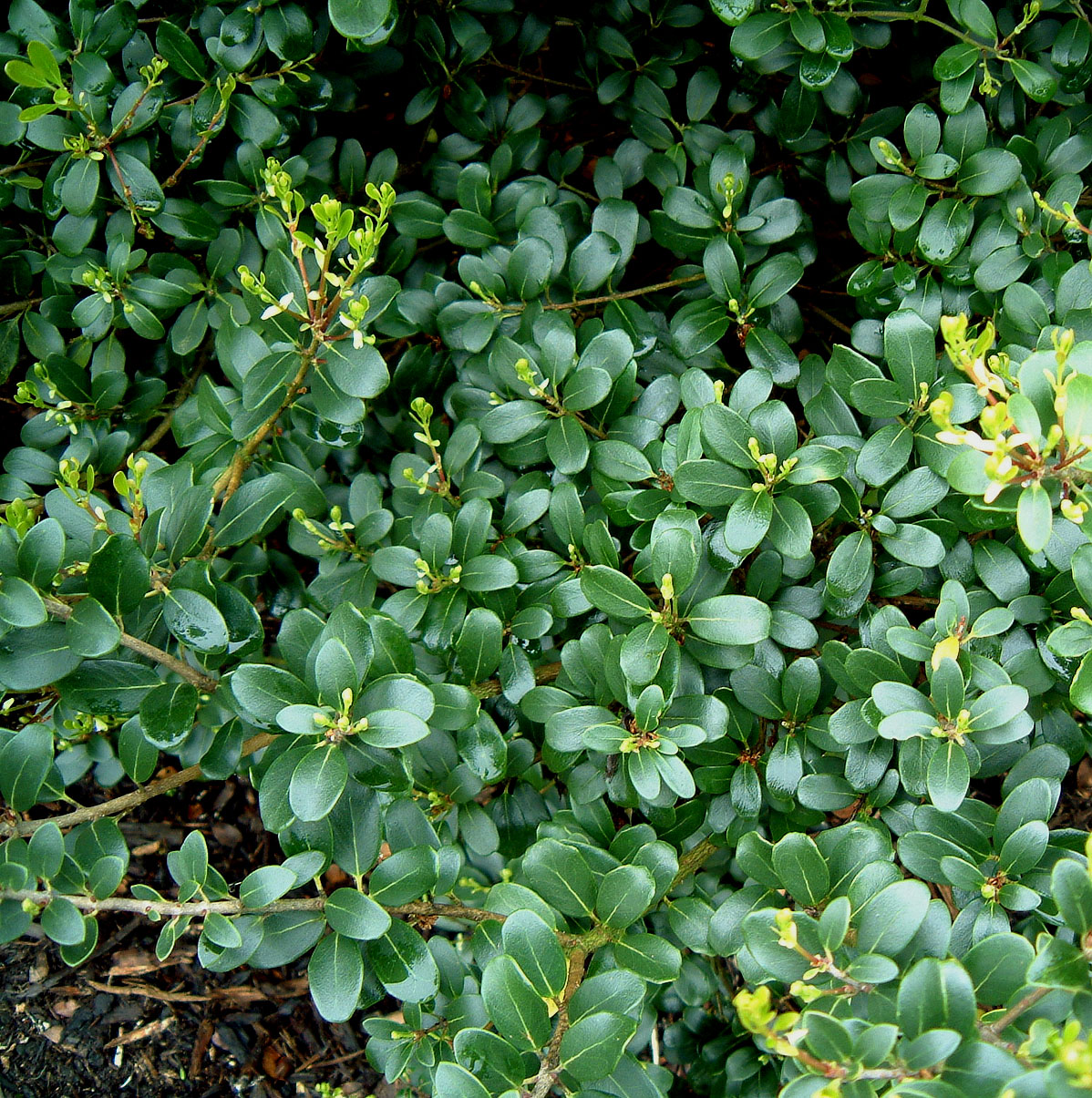 'Rotundifolius' - click image
'Rotundifolius' - click image
Osmanthus heterophyllus
'Rotundifolius'
ha: more compact and densely globose
gr: often half to 2/3 that of species for similar age.
ls: not truly rotund but more oblong with an obtuse apex.
lm: distinctly thicker than normal and often undulate (wavy) to
revolute
la: obtuse - not acute or spinose
lb: rotund - not cuneate
Osmanthus heterophyllus
'Sasaba'
ha: open and upright - not normally dense unless sheared
ha: is a typical open plant with dense tufts of dark foliage
gr: internodes 3mm-6cm
lc: dark green with distinctly light green veins and margins
ls: lobes cut nearly to the midrib forming 8-13 very long sharp
spinose
ls: teeth. They resemble a tuft of bamboo leaves and look very
ls: atypical for this genus.
pet: often purple below
li: Hahn, C.R. and B.R. Yinger. 1983. Cultivars of Japanese
plants at
li: Brookside Gardens. Arnoldia 43(4): 16.
so: under O. sasaba - Roslyn Nursery
Osmanthus heterophyllus
'Tricolor'
lc: margined white with edges pink in strong sun or cool weather
id: 'Variegatus' will not turn pink in sun. Some consider this a synonym of 'Goshiki'
but
id: the true 'Tricolor' is a marginate and not a maculate chimera.
 'Variegatus' - click image
'Variegatus' - click image
Greensboro Arboretum, NC. Summer 2003. This pretty cultivar differs from a
variegated holly in having opposite leaves, the general lack of
red winter pigments, and no red berries.
Osmanthus heterophyllus
'Variegatus'
lc: edged white - not pinkish as with 'Tricolor'
lu: sometimes sold around Christmas like a variegated holly in
pots.
Osmanthus heterophyllus
'Variegatus Latifolius'
lc: edged white
lw: wider than 'Variegatus' - we have not seen any good
measurements.
Osmanthus heterophyllus
'Willowleaf' = 'Sasaba'
 'Jim Porter' - click image
'Jim Porter' - click image
JC Raulston Arboretum. Fall 2003. We know little about this clone including
origin and species affinity. Still it remains one of
the most impressive Osmanthus (or even Ilex for that matter) for even, very
large, artistically-spaced teeth.
Osmanthus 'Jim Porter'
Osmanthus sasaba 'Willowleaf'
= O. heterophyllus 'Sasaba'
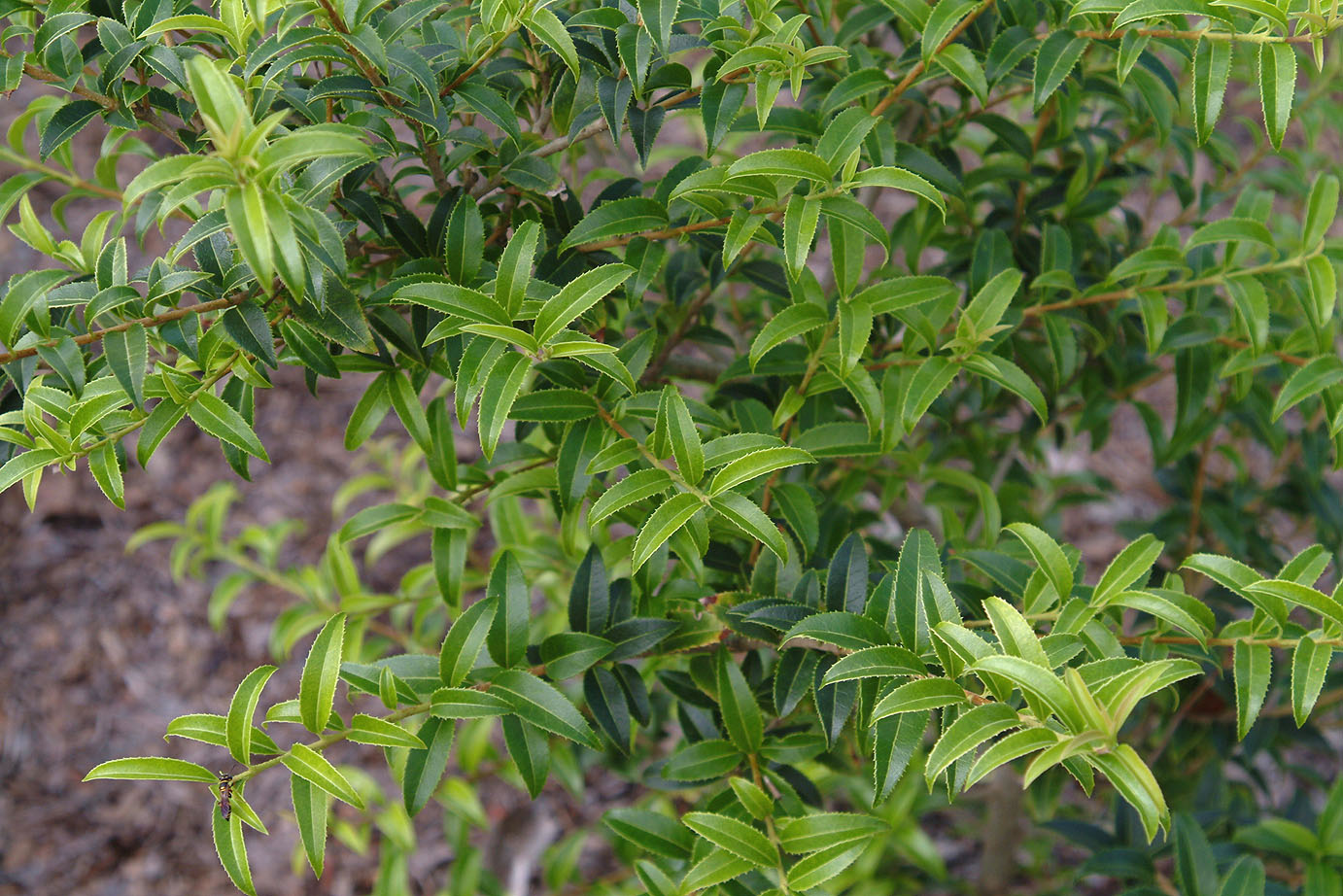 sauvis
- click image
sauvis
- click image
JC Raulston Arboretum. Summer 2003. This rare species is sauve indeed. The
narrow and very finely toothed leaves impress for their fine, regular texture.
The newer growth is a semi-glossy shade of olive green that is very appealing
against darker leaves of the year before and any other nearby shrub. This
species deserves more widespread trial. I think it could be a staple item in
warmer regions.
Osmanthus sauvis